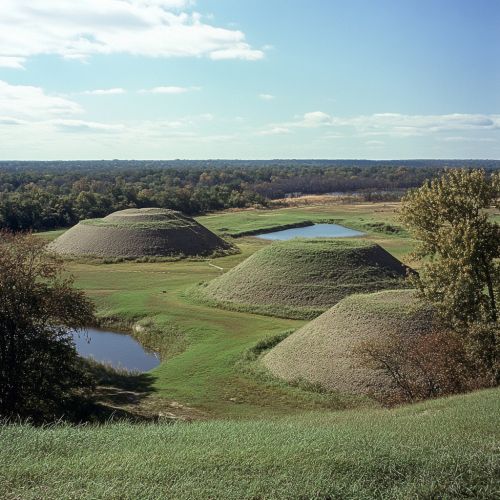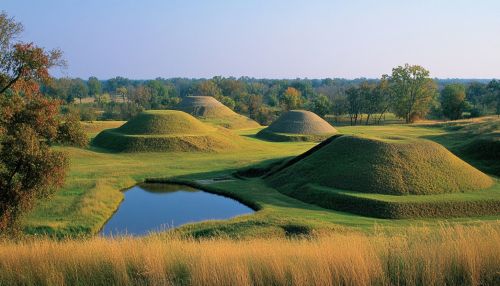Moundville Archaeological Site: Difference between revisions
No edit summary |
No edit summary |
||
| Line 15: | Line 15: | ||
== Site Description == | == Site Description == | ||
[[Image:Detail-98317.jpg|thumb|center|View of the Moundville Archaeological Site with several earthen mounds and surrounding landscape.]] | [[Image:Detail-98317.jpg|thumb|center|View of the Moundville Archaeological Site with several earthen mounds and surrounding landscape.|class=only_on_mobile]] | ||
[[Image:Detail-98318.jpg|thumb|center|View of the Moundville Archaeological Site with several earthen mounds and surrounding landscape.|class=only_on_desktop]] | |||
=== Layout and Architecture === | === Layout and Architecture === | ||
Latest revision as of 21:58, 8 October 2024
Introduction
The Moundville Archaeological Site, located in Hale County, Alabama, is one of the most significant prehistoric Native American sites in the United States. This site, which was occupied from around AD 1000 to AD 1450, was a major political and ceremonial center of the Mississippian culture. The site is renowned for its impressive earthen mounds, which were used for ceremonial, residential, and burial purposes. The Moundville site provides invaluable insights into the social, political, and religious life of the Mississippian people.
Historical Background
Mississippian Culture
The Mississippian culture, which flourished in the southeastern United States from approximately AD 800 to 1600, is characterized by its complex chiefdoms, intensive agriculture, and construction of large earthen mounds. The culture is known for its sophisticated social hierarchy, which was often reflected in the layout and construction of their settlements. Moundville was one of the largest and most complex of these settlements, serving as a regional center of power and influence.
Discovery and Excavation
The Moundville site was first documented by European settlers in the early 19th century, but it was not until the early 20th century that systematic archaeological investigations began. Clarence Bloomfield Moore conducted some of the earliest excavations in the 1900s, followed by more extensive work by the Alabama Museum of Natural History in the 1930s. These excavations revealed a wealth of artifacts and structural remains, providing a clearer picture of the site's historical significance.
Site Description


Layout and Architecture
The Moundville site covers approximately 185 acres and includes 29 earthen mounds arranged around a central plaza. The mounds vary in size and function, with the largest mounds likely serving as platforms for elite residences or ceremonial structures. The central plaza was likely used for public gatherings, rituals, and possibly markets. The site's layout reflects a highly organized society with a clear social hierarchy.
Mound Construction
The construction of the mounds at Moundville involved the labor-intensive process of moving vast quantities of earth. The mounds were built in stages, with layers of soil and clay compacted to create stable platforms. This construction technique not only demonstrates the engineering skills of the Mississippian people but also their ability to mobilize and organize large workforces.
Social and Political Structure
Chiefdoms and Hierarchy
Moundville was a paramount chiefdom, meaning it was the center of a regional political system that controlled surrounding communities. The society was stratified, with a ruling elite that likely resided on the largest mounds. This elite class controlled the distribution of resources and the organization of labor, reinforcing their power and status through religious and ceremonial activities.
Economic Activities
The economy of Moundville was based on agriculture, with maize being the primary crop. The fertile floodplains of the Black Warrior River provided ideal conditions for farming. In addition to agriculture, the inhabitants engaged in hunting, fishing, and gathering wild resources. Craft production, including pottery, stone tools, and shell ornaments, was also an important aspect of the economy.
Religious and Ceremonial Life
Cosmology and Rituals
The Mississippian people had a complex cosmology that was reflected in their religious and ceremonial practices. The mounds at Moundville were likely used for rituals that reinforced the social and political order. Artifacts such as effigy vessels, ceremonial axes, and engraved shell gorgets found at the site suggest a rich symbolic and religious life.
Burial Practices
Burial mounds at Moundville provide insights into the society's beliefs about death and the afterlife. The dead were often buried with grave goods, including pottery, tools, and ornaments, which indicate the individual's social status. The presence of elaborate burial goods in some mounds suggests the existence of a powerful elite class.
Art and Iconography
Pottery and Artifacts
Moundville is renowned for its distinctive pottery, which features intricate designs and motifs. These designs often depict mythical creatures, such as the Underwater Panther and the Birdman, which are central figures in Mississippian iconography. The pottery serves not only as functional items but also as a medium for artistic expression and communication of cultural beliefs.
Symbolism and Meaning
The iconography found at Moundville reflects the complex belief system of the Mississippian people. Symbols such as the hand and eye motif, the cross-in-circle, and the weeping eye are common in Moundville art and are thought to represent cosmological concepts, such as the division of the world into upper, middle, and lower realms.
Preservation and Interpretation
Modern Archaeological Work
Ongoing archaeological research at Moundville continues to uncover new information about the site's history and significance. Advances in technology, such as ground-penetrating radar and remote sensing, have allowed archaeologists to explore the site in non-invasive ways, revealing previously unknown features and structures.
Public Education and Engagement
The Moundville Archaeological Park, managed by the University of Alabama, serves as a center for public education and engagement. The park includes a museum that houses many of the artifacts recovered from the site, as well as interpretive trails and educational programs that aim to increase public awareness and appreciation of this important cultural heritage site.
